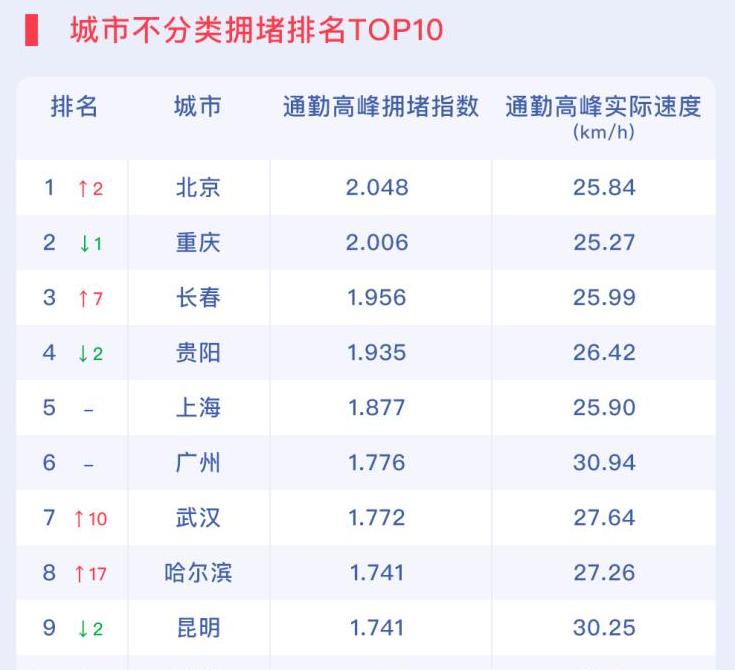For friends who drive to work, morning and evening rush hour traffic jams are all too familiar, and with the sharp increase in domestic car ownership, vehicle congestion has been further aggravated. In people's minds, the larger the city, the more likely it is to generate congestion, but is this really the case? Last month, Baidu Maps released the "2021 China Urban Commuting Peak Congestion List", which uses the commuting peak congestion index, which refers to the ratio of the actual travel time recorded by the software background big data to the smooth travel time during the morning and evening rush hours on weekdays, and the larger the ratio, the more serious the congestion.
In the ranking of unclassified congestion, only the imperial capital Beijing has retained its "status" in the four super-first-tier cities of Beijing, Shanghai, Guangzhou, and Shenzhen, rising two places compared with 2020, and reaching the top again, followed by Chongqing, Changchun and Guiyang. Shanghai and Guangzhou ranked fifth and sixth respectively, while Shenzhen did not rank in the top ten of the list, which also reflects the advantages of emerging cities in transportation planning.

There is no distinction between car ownership in the above rankings, so the reference significance is relatively limited, so let's look down at how the rankings will change between cities with different car ownership levels. The first is the city with more than 3 million car ownership, in this list, the ranking may be closer to everyone's cognition, because most of the list is a large city with a population of more than 10 million, and The top three in Beijing, Chongqing, and Shanghai are metropolises with a population of more than 20 million, and the pressure on transportation can be seen how great. In particular, Chongqing, known as the mountain city and the fog capital, can be seen from the actual speed of the commuting peak of 25.27km/h, and the geographical and climatic conditions have a greater impact on traffic.
Changchun is a city with a car ownership between 2 million and 3 million, Changchun can be described as a thriving city, not only the congestion index is much higher than that of the cities behind it, but also the actual speed of commuting peaks is also quite different from other cities. As the birthplace of FAW, Changchun is one of the earliest automobile cities in China, at the same time, as one of the old industrial bases in Northeast China, the planning of the old city has relatively large limitations, the difficulty of road transformation is much more difficult than that of emerging cities, and the development of public transportation is also difficult to catch up with people's needs. In this list, it is not difficult to find that in addition to a few cities with low commuting speeds, the commuting speed of most cities is not low, indicating that the transportation construction of these cities is relatively well developed, and the carrying capacity of urban roads for automobile traffic is relatively strong.
In the car ownership of 1 million -2 million cities, most of them are the capital cities of provinces with relatively poor economies, Guiyang, Fuzhou, Lanzhou, etc., are in a critical period of economic development, transportation infrastructure is still lagging behind, Guiyang's situation is similar to Chongqing, affected by geographical and climatic factors. In addition, it can be seen from the actual speed of commuting peaks that most of the cities with larger holdings below the above figure also support the reality of backward traffic conditions.
In cities with less than 1 million car ownership, the problem of traffic management may be more prominent than in other cities, compared with the overall development scale of the city, the number of car ownership has not yet reached saturation. The distribution trend of the list is similar to that of 1-2 million cities.
The development of a city cannot expand outward indefinitely, and the problem of traffic congestion is not only a way to expand the road. The development and improvement of public transportation is also one of the practical ways, there are more and more new technologies applied to traffic management, Baidu president Robin Li proposed at the artificial intelligence conference a few years ago, the application of AI intelligent technology can reduce people's waiting time in traffic congestion by 30% to 40%, perhaps in the near future can really become a reality. Did your city make it onto the list? What do you think are the methods of "blocking"? Feel free to point it out in the comments. (Text/UVIS Auto Ride)
Note: The picture comes from the network, the rights belong to the original author, thank you! This article only represents the personal views of the author and does not represent the position of Univision Automobile.